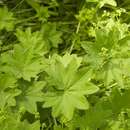Biology
provided by Arkive
A. minima flowers from June to September and is a perennial. Where it occurs, the turf communities are closely grazed and the plant is able to set seed successfully at ground level, whereas larger Alchemilla species would have their flowers grazed by sheep. However, the plant is also able to survive vegetatively when overgrazing takes place. When A. minima was first identified as a species in its own right, it was regarded as an example of evolutionary selection resulting from its ability to survive intensive sheep grazing.
Conservation
provided by Arkive
English Nature has included A. minima in its Species Recovery Programme with the aim of maintaining the plant as viable British species. It is also listed on the UK Biodiversity Action Plans. The chief aims of the action plan are to maintain the existing populations and to create a reserve collection of plants in nurseries. This will include seed collection for storage at the Millennium Seed Bank run by the Royal Botanic Gardens, Kew.
Alchemilla minima has probably always been an uncommon plant in Britain and a priority will be to clarify its individual status as a distinct species. Since the habitat management currently employed is solely based on knowledge of one, small area, it is important that the full distribution of this plant is known. There needs to be a greater understanding of the ecology of this interesting member of the lady's mantle family.
Description
provided by Arkive
This plant has no common English name but belongs to the well-known lady's mantle family. It was only recognised as a separate species in 1947, and today it is usually regarded as a variety of Alchemilla filicaulis, a widespread and very variable plant.
A. minima is a diminutive plant, with leaves that are smaller than many other species in its family. However, it shares the family trait of having hairs on its leaves which catch the morning dew. This feature led to the origin of the family name. Alchemilla means 'little alchemist', and refers to the practice during the Middle Ages of trying to turn base-metals into gold. Alchemists required the purest dew for their experiments, which was gathered from the leaves of the lady's mantle.
The medieval herbalists also used this dew for treating wounds. In the course of time, such a powerful and valuable plant became Christianised and was named 'Our Lady's Mantle'.
Habitat
provided by Arkive
This species rarely occurs below an altitude of 300 metres. It requires a moist environment, either through rainfall or by inundations of fresh water. It is principally associated with other plants that grow on limestone bedrock.
Range
provided by Arkive
A. minima is only found in the UK where its known range is limited to limestone outcrops on two Yorkshire fells. Due to its small size, colonies are constantly being discovered, but all fall within this limited area. Other recorded sightings of the plant are treated as doubtful.
Status
provided by Arkive
Classified as Vulnerable in the UK- endemic to UK.
Threats
provided by Arkive
Alchemilla minima does not, at this moment, appear to be a threatened plant. However, the extremely restricted range and the difficulties in managing its habitat closely, means that it is important to ensure that it does not become a threatened species.
The sites where the plant occurs are currently protected by English Nature as Sites of Special Scientific Interest and part of the area is managed as a National Nature Reserve (NNR). Within the boundaries of these areas, A. minima colonies can be monitored closely and the grazing strictly controlled. Outside these areas, however, the plant remains a species at risk.
Comprehensive Description
provided by North American Flora
Alchemilla filicaulis Buser, Bull. Herb. Boiss. 1 :
App. 2 : 22. 1893.
Perennial, with a creeping rootstock ; stems 1-3, ascending or decumbent, 1-3 dm. high, slender, hirsute with spreading hairs, becoming yellowish in age ; basal leaves long-petioled ; stipules usually wine-color, lanceolate, entire ; petioles 3-10 cm. long, hirsute ; leaf-blades reniform, 3-9 cm. broad, rather thick, plane, with 7-9 rounded lobes, bright-green above, paler beneath, turning somewhat yellowish in age, hairy on both sides or glabrate beneath ; teeth a little longer than broad, ovate, cuspidate ; stipules of the stem-leaves
rounded, connate and adnate to the petiole or leaf -blade, provided with coarse ovate teeth ;
inflorescence partly subumbellate ; hypanthiutn at first obconic, in age urceolate, about 2
mm. long, at least of the lower flowers pubescent with scattered hairs ; pedicels about the
length of the flowers ; bractlets lanceolate, nearly as long as the triangular-ovate acute
sepals, which are about 1 mm. long ; filaments very short.
Type locality : Switzerland.
Distribution : Mountains of western Europe, Scandinavia, Iceland, Greenland, Labrador, and Newfoundland.
- bibliographic citation
- Per Axel Rydberg. 1908. ROSACEAE (pars). North American flora. vol 22(4). New York Botanical Garden, New York, NY
Alchemilla filicaulis
provided by wikipedia EN
- license
- cc-by-sa-3.0
- copyright
- Wikipedia authors and editors
Alchemilla filicaulis: Brief Summary
provided by wikipedia EN
Alchemilla filicaulis is a species of plants belonging to the family Rosaceae.
It is native to Europe and Northern America. It is a known host species to at least two species of pathogenic fungi, Peronospora potentillae and Ramularia aplospora.
- license
- cc-by-sa-3.0
- copyright
- Wikipedia authors and editors

